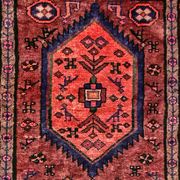Difference between revisions of "Taleghan Rug"
| Line 71: | Line 71: | ||
== Bibliography == | == Bibliography == | ||
* Abraham Levi Moheban, (2015), ''[[The Encyclopedia of Antique Carpets|The Encyclopedia of Antique Carpets: Twenty-Five Centuries of Weaving]]'', NewYork: Princeton Architectural Press. | * Abraham Levi Moheban, (2015), ''[[The Encyclopedia of Antique Carpets|The Encyclopedia of Antique Carpets: Twenty-Five Centuries of Weaving]]'', NewYork: Princeton Architectural Press. | ||
| − | + | * Peter F. Stone, (2013), ''Oriental Rugs: An Illustrated Lexicon of Motifs, Materials, and Origins'', North Clarendon :Tuttle. | |
[[Category:Alborz Rug and Carpet]] | [[Category:Alborz Rug and Carpet]] | ||
[[fa:قالی_طالقان]] | [[fa:قالی_طالقان]] | ||
Revision as of 11:15, 3 March 2020
| Taleghan Rug | |
|---|---|
 Design of Taleghan Rug (Rugman) | |
| General information | |
| Name | Taleghan Rug |
| Original name | قالی طالقان |
| Alternative name(s) | Taleghan Carpet |
| Origin | |
| Category | Village |
| Technical information | |
| Common designs | Medallion (Toranj) |
| Common colors | Red, Navy Blue, Cream |
| Dyeing method | Natural, Synthetic |
| Pile material | Wool |
| Foundation material | Cotton |
| Knot type | Symmetrical (Turkish) |
Taleghan is a small town southwest of the city of Tehran, in central Iran. It produces a series of beautiful and carefully constructed handmade rugs, which closely resemble the legendary rugs of Kashan and some other fine rug producing centers in central Iran. Taleghan rugs usually have a traditional floral spray design, with a carefully designed medallion, usually on a background of red, burgundy, or fuchsia. The quality of these rugs is marvelous.
History
Taleghan, also spelled Taleqan, is a weaving town located in the foothills of the Alborz Mountains in the Alborz Province of north central Iran. It is situated seventy-five miles (120 km) northwest of the capital city of Tehran. The rugs are known in the antique market from the late nineteenth century.[1]
Materials
Foundation and Pile
They have a cotton foundation and a medium to long wool pile.[2]
Techniques and structures
Color and dyeing
Most Taleghans have dark blue or reds for the background and main border coloration. Addition ally, different shades of green, gold, brown, cinnamon and coral are employed in the design elements, medallion, quadrants, and minor borders. Dark brown or black is applied in design outlines.[3]
Motifs and Designs
Taleghan rugs have semigeometric designs in a medallion or allover style. Field designs include traditrional Boteh (paisley) or Herati (fish) patterns featuring a variety of tribal motifs. In the medallion style, the center has a lozenge-shaped or hexagonal motif with stylized quadrants in each corner of the field. Taleghan weavers incorporate field and border designs from the Hamadan and Zanjan Provinces. Flatwoven Kilim rugs and Jajim Rugs are also made in geometric, tribal styles.[4]
Weaving techniques
The formats range from small mats to rugs approximately seven feet by four feet six inches; runners are also produced. They have a cotton foundation and a medium to long wool pile tied in the Turkish (symmetric) knot. Taleghan rugs are durably woven and make for long-lasting floor coverings.
A symmetric knot is used at a density of about 65 knots per square inch.[5]
By the last quarter of the twentieth century, many Taleghan weavers switched from making traditional designs to produce styles similar to those of other areas to meet domestic and foreign export demand.[6]
See also
| Search for Taleghan Rug on Wikipedia. |
References
Bibliography
- Abraham Levi Moheban, (2015), The Encyclopedia of Antique Carpets: Twenty-Five Centuries of Weaving, NewYork: Princeton Architectural Press.
- Peter F. Stone, (2013), Oriental Rugs: An Illustrated Lexicon of Motifs, Materials, and Origins, North Clarendon :Tuttle.



